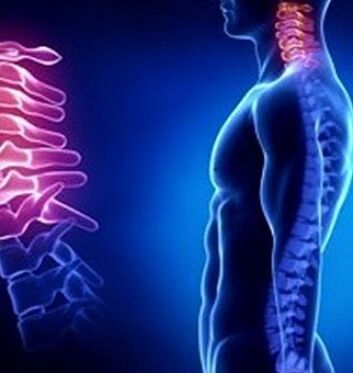
In osteochondrosis, there is a gradual destruction of the tissues of the spine, leading to a violation of its function. In general, such degenerative processes occur in most mobile departments. In young people, cervical osteochondrosis is most commonly observed. The instability of this class, along with increased physical activity, explains its predisposition to injury and various dystrophic processes. In 3 out of 10 cases, he causes a sudden headache. Osteochondrosis causes a metabolic disorder in the spine. Because of this, the discs in it will stick out and then crack.
Symptoms
There are several signs of dystrophic changes in the spine. They are more pronounced or weaker depending on the stage of the disease. Cervical osteochondrosis has the following symptoms:
- Pain in the neck, neck, shoulders. It confirms even under light load.
- Numbness in the limbs.
- Crack in the neck.
- The headache is mainly localized in the occiput and temple.
- Fainting, chronic fatigue.
- Noise in the ear, hearing loss.
- Loss of visual acuity.
Cervical osteochondrosis may also be indicated by tensile pain in the heart region. The patient often has feelings similar to angina pectoris. Other disorders occur when the spinal cord is pinched. For example, loss of tongue sensation or loss of neck muscle tone, breathing problems. If treatment is not prescribed in time, the patient may develop a protrusion or hernia.
There are four stages to osteochondrosis. The first is characterized by instability of the intervertebral discs. On the second, the protrusions are considered the main sign. In this case, the gaps between the vertebrae are smaller. There is pain syndrome that can be caused by pinching of the nerve roots.
In the third stage, the fibrous ring, which is an integral part of the intervertebral disc, is destroyed. Therefore, it deforms later. A patient with the fourth stage of cervical osteochondrosis feels severe pain with any movement. It should be noted that a decrease in intensity does not indicate healing. On the contrary, it indicates that the formation of osteophytes connecting the vertebrae has begun. This usually leads to disability. Treatment is prescribed based on the stage of development of clinical symptoms and pathology.
Causes of the disease

Sedentary work is most often accompanied by cervical osteochondrosis. This spinal section is quite compact, so even mild muscle tension leads to compression of nerve endings and blood vessels. This is often caused by the development of osteophytes, which only makes the situation worse. In addition to a sedentary lifestyle, the disease can be caused by:
- metabolic disorders;
- malnutrition;
- salt deposition in the cervical spine;
- hypothermia;
- hereditary predisposition;
- cervical spine injuries;
- rheumatism.
Curvature or obesity of the spine can also be the cause of the disease. The risk group includes those with poor physical fitness or athletes who make mistakes during the training process.
Which doctor treats osteochondrosis of the neck?
In order to avoid the development of complications at the first signs of pinching of the nerve roots of the spine, you should seek medical help. Osteochondrosis and symptoms of the cervix are treated by neurologists, chiropractors and osteopaths.
In addition, you may need to consult a neurosurgeon, traumatologist, therapist, or cardiologist. To differentiate the diagnosis, the doctor analyzes the patient’s complaints. In this section, he asks the patient the following questions:

- When did the neck pain first appear?
- Are other symptoms associated with cervical osteochondrosis?
- Is the patient's professional activity related to lifting weights or keeping the neck still for a long time?
- What is the patient's level of fitness?
- Does the patient have any signs of neurological abnormalities?
To assess the condition of your spine, your doctor will prescribe an X-ray, CT scan, or MRI. Depending on the symptoms and stage of the disease, treatment may include massage, swimming, and exercise. The local processes of destruction are affected by acupuncture. With severe pain syndrome, your doctor will prescribe anesthetics. Muscle tension is released by muscle relaxants. In advanced cases, when the patient has an injury that compresses the roots of the spinal cord, surgery is needed.
What if the disease is not treated?
In the absence of qualified medical care, the patient eventually develops chronic pain in the cervical spine. It radiates to the upper and lower limbs, resulting in paralysis. As osteophytes grow, they compress the nerve channels, veins and arteries. This can disrupt the cerebral circulation. This often causes ischemia and spinal cord stroke. The patient's vision and hearing also deteriorate, and migraine and vegetovascular dystonia occur.
When studying cervical osteochondrosis and its clinical symptoms, doctors often diagnose radiculopathy. This leads to a partial or complete loss of vertebral mobility. The occurrence of exacerbations is the reason for the patient's hospitalization. The most serious consequence of osteochondrosis of the neck is compression of the spinal cord. The risk of death in this case is quite high. A doctor should be consulted as soon as possible to avoid complications. The working method should be gentle. Perform special gymnastics and, if possible, morning exercises every day.


























